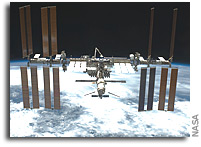NASA International Space Station Lead Increment Scientist’s Highlights, weeke ending April 18, 2011

(Highlights: w/e April 18, 2011) — The Earth Knowledge Acquired by Middle School Students, or EarthKAM, experiment was completed. EarthKAM is an experiment that allows middle school students from all over the world to program an onboard digital camera to take photographs of selected targets on Earth. The images are used to study land use, coastline erosion, volcanoes, deforestation and many other topics. One hundred and seventy-three schools with 14,351 students participated. A total of 1438 images were taken.
Through April 13, 5,735 images have been cataloged during Expeditions 27/28 for the Crew Earth Observation, or CEO, investigation. Recent images include the Shebelle River in southeastern Ethiopia and Aurora Borealis, Alaska. For this experiment, station crew members photograph natural and human-made changes on Earth. These images provide researchers with key data to better understand the planet.
Experiment runs of the DEvice for the study of Critical LIquids and Crystallization Alice Like Insert, or DECLIC-ALI, experiment were completed. This investigation examines how heat flows in liquids which are just below the critical point in microgravity.
Cady Coleman completed another session with the Evaluation of Maximal Oxygen Uptake and Submaximal estimates of VO2max before, during and after long-duration space station missions, or VO2max. The experiment documents changes in maximum oxygen uptake over long-duration missions.
In conjunction with VO2max, Coleman performed another session of ESA-sponsored Thermoregulation in Humans During Long-Term Spaceflight, or Thermolab. This investigation evaluates the thermoregulatory and cardiovascular adaptations during rest and exercise in the course of a long-duration microgravity exposure.
Two crew members completed sessions with the Nutritional Status Assessment, or Nutrition. This comprehensive in-flight study is designed to understand changes in human physiology during long-duration spaceflight. This study includes measurements of bone metabolism, oxidative damage, and chemical and hormonal changes; as well as assessments of the nutritional status of the crew members participating in the study. The results have an impact on the definition of nutritional requirements and development of food systems for future space exploration missions.
Vic Cooley, Lead Increment Scientist Expedition 27/28









